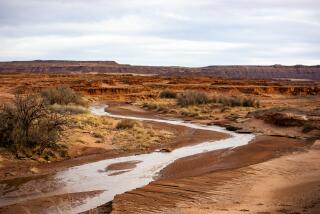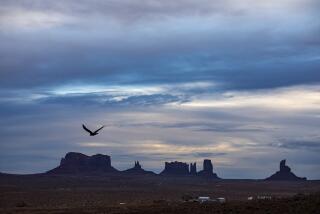Fourth Year of Drought Looms in Parched Southern Africa : Zimbabwe: Across vast tracts of land, water shortages have dried once- fertile fields and evaporated reservoirs. Growing and shifting populations increasingly overtax supplies.
- Share via
SELOUS, Zimbabwe — Roy Fuller pointed his lanky arm toward a parched creek bed and, smiling wryly, described the good old days when water thundered by.
“I used to have sleepless nights,” the farmer said almost wistfully. “I’d hear the water come racing and I’d get up and say, ‘What happened? Did a dam burst?’ ”
No dams burst anymore in this sun-grilled region near Harare in northern Zimbabwe. Few reservoirs have enough water for swimming. On Fuller’s 3,000-acre spread, tobacco leaves wither and crackle while cornstalks the color of sand break in the wind.
Fuller still cannot sleep, tormented now by mounting debts. At 55, he talks with neighbors about raising millions of dollars for a dam that would provide plentiful water for a decade, “if it fills.”
Across vast tracts of southern Africa, four years of poor rains--the worst drought in memory--have dried once fertile fields and evaporated reservoirs. Meanwhile, growing and shifting populations increasingly overtax water supplies.
At least seven nations have some degree of drought this year, draining already weak economies and consuming larger shares of shrinking foreign aid money.
Those who study the problem warn that the region has used most of the available water and nature has slowed in providing fresh supplies. In the short term, that means more frequent and widespread drought. In the long term, it means learning to get by with less or facing disaster.
“We seem to work on the premise that water will always be there,” said Hugh Bowen Williams, chief engineer in the planning branch of Zimbabwe’s department of water development. “It hasn’t quite sunk in that we’re a semiarid region. Water scarcity is here to stay.”
Unlike well-publicized, war-exacerbated drought and famines in Ethiopia, Sudan and Somalia, the southern African drought stems from a combination of more people, more development and less rain. Few people die, and stockpiled food, imports and foreign aid generally prevent widespread hunger.
But the recurring crises prompt harmful emergency measures. Governments spend more of their meager funds to build larger dams and link longer pipelines, depriving rivers and aquifers of water flow needed for irrigation, drinking water and other uses. People dig deeper wells and drain ground water faster.
Malawi and Mozambique, two of the world’s poorest countries, are seeking more foreign aid. Namibia, a largely desert region on the Atlantic Coast, is considering a $22-million desalination plant that would provide drinking water to cities.
In Botswana, about two-thirds of which is the Kalahari Desert, water is so precious that the currency is called the “pula,” the tribal word for rain. Consumers pay roughly three times as much for water as in neighboring South Africa, meaning less money for economic development. The government plans to spend $440 million on a new dam for Gaborone, the capital.
South Africa faces increasing demands on water supplies. President Nelson Mandela’s government has promised clean, running water to millions of poor blacks ignored by previous white rulers.
It is considering conservation measures such as heavy fees on large water consumers and bans on inefficient forms of irrigation while looking beyond its borders for future sources. A multibillion-dollar project has started with Lesotho, which South Africa surrounds, to pump mountain water through a huge tunnel to the Johannesburg area.
Zimbabwe says it needs food imports or donations to feed half its 10 million people for the next 15 months. The second-largest city, Bulawayo, just increased water restrictions on homes, hospitals, schools and industry and faces the unprecedented possibility of running dry this year.
“It’s never happened, really, anywhere in the world,” said Mike Constandinos, longtime city alderman and a vocal water activist. “What do you do with 1 million people?”
Dams supplying the bulk of city water are only a bit over 10% full. Rationing imposed in January failed to slow consumption, so the City Council approved stricter measures--450 liters (118 gallons) a day per house, with fines for using more.
With what there was of the rainy season just ending, the restrictions are intended to cut consumption at least 20% from a year ago. That should extend the available water until November, formerly the start of new rains, but Constandinos noted little rain has fallen in November the last four years.
Without water, sewers would clog with waste and eventually burst, Constandinos said, describing a hopeless scenario of industry shutting down and wealthy whites moving out while poor blacks unable to leave would require emergency help such as trucked-in water.
Bulowayans blame President Robert Mugabe’s government, in power since independence in 1980, for failing to properly develop city water supplies in a tribal-based feud between his Shona people and the Ndebeles dominant in the region.
But water problems near the encroaching Kalahari, about 60 miles southwest of Bulawayo, date back decades. Constandinos mentioned the 1947 drought, when city officials drew lines in bathtubs to mark acceptable water levels. He showed a copy of a 1912 flier advertising a public meeting to discuss diverting water from the Zambezi River, 240 miles to the north.
More than 80 years later, the Zambezi still represents salvation for Bulawayo and perhaps the entire southern region. Africa’s fourth-largest river passes through or along the borders of six countries, nurturing wildlife and millions of people along its banks.
“We are taking life from it,” said Blessed Mpofu, 18, who paddles canoes full of tourists above Victoria Falls.
The Zambezi provides people with water and fish, while the mile-wide falls attract tourists who spend on hotels, restaurants, rafting cruises, curios and black market transactions.
The 11-nation Southern African Development Community is expected to vote later this year on protocols for deals involving the river. But with water becoming scarce, wrangling over the Zambezi could increase regional tensions.
Environmentalists say thinking must shift toward conserving existing resources, not exploiting new ones.
“The challenge now is to put as much human ingenuity into learning how to live in balance with water as we have put into controlling and manipulating it,” Sandra Postel wrote in “Last Oasis,” a book published by the environmental group Worldwatch.
Farming presents a special regional problem. Most southern African economies are based on agriculture, which accounts for 50% to 80% of water consumption. Agriculture officials say the cost of water, often kept low by government subsidies, must rise.
Looking at his farm outside Harare, Fuller admitted the lingering drought has weakened his once stubborn optimism. Hearing a neighbor say the farmer’s watchword--”Next year’ll be better”--he smiled softly and shook his head.
“He’s young,” Fuller said. “I used to be like that, once upon a time.”
More to Read
Sign up for Essential California
The most important California stories and recommendations in your inbox every morning.
You may occasionally receive promotional content from the Los Angeles Times.













